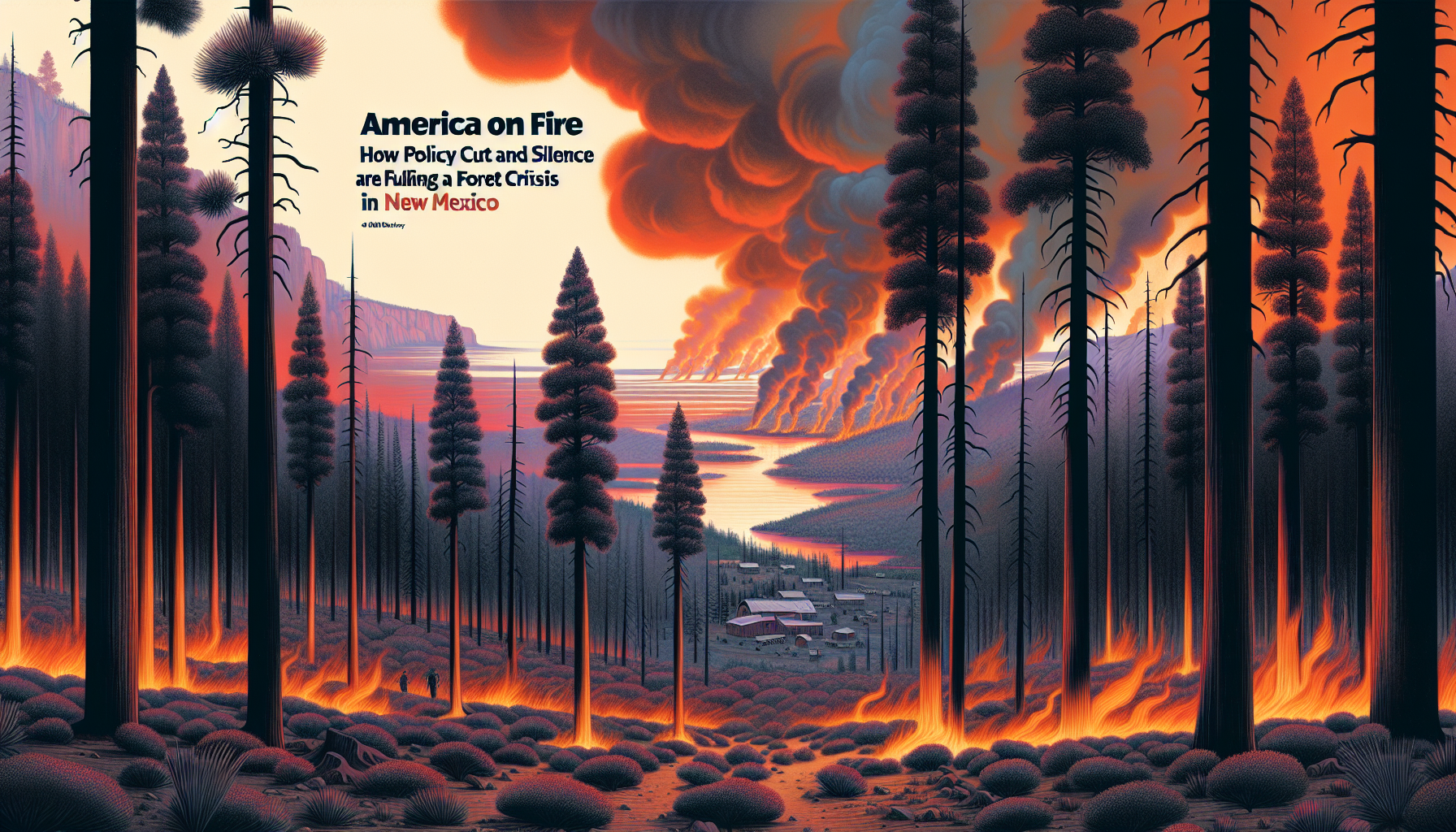Title: When the Forest Falls Silent: New Mexico, Trump’s Cuts, and the American Reckoning with Fire
Dear readers,
There’s a certain kind of hush that hangs in the pine-studded air of the Zuni Mountains—once, it was the stillness of winter snow and pine needles underfoot, now replaced by the dry crackle of a land on edge.
And beneath that quiet lies a slow-burning anxiety. No, not just about drought. Not only about wildfires either. But about something bigger: What happens when a nation’s guardians of the land are systematically stripped of their ability to guard it?
Let’s talk about fire—not the kind burning through trees, but the one creeping through policy, morale, and the future of public lands in New Mexico.
🟠 A Landscape of Smoldering Tension
In a place like McGaffey, New Mexico, fire is no metaphor. It’s real, immediate, and dangerously close.
Brian Leddy knows this viscerally. His historic Forest Service cabin, typically surrounded by the moist slush of late winter, now bakes in abnormal dryness. The threat of fire? Imminent. The choice of insurance companies to deny his coverage this year? Devastating. But it’s not just nature setting the region alight.
This season, it’s policy.
Enter the Trump Administration's Department of Government Efficiency (DOGE)—with cuts so sharp they bleed through staff rosters. Hundreds from the U.S. Forest Service laid off. Thousands more whispered to follow. A terrain already parched by climate volatility is now sabotaged from within.
🟠 A New Kind of Fireline: Burnout and Bureaucracy
“Who’s going to respond if a fire starts?” Leddy asks, voice tinged with defeat. “Right now, it doesn’t feel like there’s a lot of confidence that the federal government is going to act accordingly.”
He’s not being alarmist—he’s being observant.
Here’s the scene behind the curtain: Prescribed burns left unfinished. “Slash piles” of dead branches dried to the kindling point, stockpiled like misplaced time bombs. Restoration projects in limbo. Entire firefighting teams halved or worse, with some elite crews reduced to shadows of what they once were.
And then there’s Kayla—a New Mexico native and Forest Service worker who saw her dream job vanish without warning. Even after a court ruling temporarily reinstated her position, the damage lingers. “It’s a ticking time bomb,” she told NPR. “We were doing everything we could to prevent catastrophic fires.”
Now? Prevention has been postponed.
🟠 The Fiction of Readiness, the Reality of Retreat
The Trump Administration claims firefighting roles are “exempt” from the freeze. But boots on the ground tell a different story.
The Forest Service declined interview requests, repeating that their readiness is “not impacted.” Meanwhile, people like Eytan Krasilovsky of the Forest Stewards Guild describe a system buckling under its own contradictions. “If your nine-to-five is in turmoil, you’re not showing up to prescribed burns or forest thinning projects,” he says plainly.
Forget the talking points—listen to the silence where federal support used to be. That, too, is an impact.
🟠 The People Left Smoldering
Take AnJanette Brush, County Commissioner of Taos County—where half the land is federal. Her community, scarred from January’s Los Angeles fires and reeling from a dry winter, seems abandoned. “That’s when we really started to hear the panic,” she said. Not concern. Not worry. Panic.
And maybe they’re not wrong to feel it.
Because in a place where memories of the 2022 Hermit’s Peak fire—the deadliest in New Mexico’s history—still blaze in people’s minds, the lack of visible federal coordination is less a bureaucratic failing and more a betrayal. It’s the government’s own people who are saying it now: “We don’t feel like D.C. has our backs.”
🟠 Bureaucracy vs. the Brush: A Culture Clash
Still, not everyone’s pointing fingers in the same direction.
Bill Siebersma, a veteran trail builder in the Cibola National Forest and general backer of Trump’s administration, voices an oft-repeated sentiment: “The further you go up, the more people pushing paper. I don’t know what they do.”
This tension isn’t new. History in the rural West remembers rights curtailed, red tape thickened, and federal oversteps—especially among Indigenous and Hispano landowners whose livelihoods were complicated or criminalized by conservation laws introduced half a century ago.
And yet, here is where ideology trips over reality.
Because while Siebersma proudly sports a bumper sticker that reads “Public Lands Owner,” even those skeptical of government overreach can’t avoid this truth: when the federal government disappears, so does protection.
🟠 Lessons Not Yet Learned
Let’s be blunt: This isn’t just about the Forest Service. It’s about what happens when a government trims its limbs so thin, it forgets it needs them to keep standing.
New Mexico isn’t tinder dry solely because of weather. It’s dry because of disinvestment. Neglect. The erosion of expertise and infrastructure—executed as policy, justified as “efficiency,” but felt as abandonment.
Because the fire doesn’t care who you voted for. It doesn’t wait for funding to be restored. It doesn’t check if a grant was delayed by climate denial politics.
It just burns.
🟠 Who Will Guard the Guardians?
We’re not just witnessing staffing cuts. We’re watching the quiet disassembly of a relationship—between citizens and the institutions meant to serve them.
And just as Mickey Rourke’s implosion on Celebrity Big Brother was a spectacle of celebrity decay, this is the slow-motion collapse of stewardship—one built not on slogans, but on soil, sweat, and strategy.
So let me ask you: When the forests fall silent, and fires roar louder than phone lines, who will answer the call?
Until next time, stay vigilant. Because in today’s America, even wildfire response can become partisan—and silence, as ever, is far from neutral.
Yours in smoke and signals,
A Watcher of Forests & Failures

